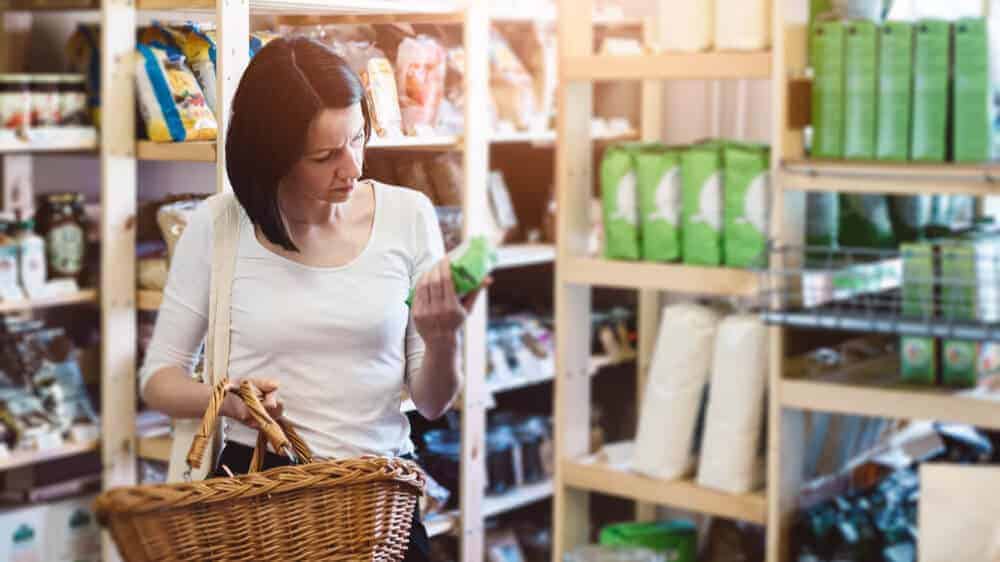The FDA’s Relaxed Food Labeling Guidelines in Response to the Pandemic are Dangerous
The following post is part of our series on perspectives from disabled and chronically ill people regarding COVID-19.
If I hadn’t been born in the 20th century, I wouldn’t have survived infancy. Yet here we are, after decades of work to be sure people with chronic illnesses are able to keep ourselves safe, in the middle of a pandemic, and our government has essentially declared our safety “non-essential”. We have food allergies, mast cell activation syndrome (MCAS), diabetes, irritable bowel syndrome (IBS), Crohn’s disease, postural orthostatic tachycardia syndrome (POTS), Ehlers-Danlos syndrome (EDS), and many other health conditions and disabilities that require specialized diets to stay alive. I’m in that list, so I’m taking this personally.
The day the U.S. Food and Drug Administration (FDA) announced they would relax labeling laws, I was on the phone struggling to get information about inactive ingredients in a family member’s emergency medication. The pharmacy claimed not to have any information since it’s a generic version, and the company website provided few specifics. After three hours of research, we had a tense family conversation about risk assessment. (If an inactive ingredient caused anaphylaxis, was it safe to go to the emergency room during a pandemic?) Fortunately, that didn’t happen. But the question remains: what about next time? Some of this felt extremely familiar.
Let me take you time-traveling.
***
Back almost 50 years, pre-allergen labeling laws
At a few weeks old, I have what seem to be multiple allergic reactions after nursing. So my mother tries to find a safe (corn and dairy-free) formula. There are not yet labeling laws for allergens, and since most companies won’t share that information, finding safe formula was difficult. About the time she finds a formula that keeps me alive, someone in the government has it removed from shelves (ironically out of concern about whether an ingredient is healthy). And so my mother has to make many phone calls and drive sometimes for hours to find stores that still have even a case of the formula. Eventually, my parents contact the company that makes it, and the head of the organization agrees to meet my mother secretly at a gas station where she will open her trunk, and he’ll put in the boxes of whatever they have left. Yes, really.
Around 1976
My parents notice that my sister and I are getting sick quite frequently. Ear infections, rashes, blisters, stomach problems, obviously depleted immune systems. One thing almost all chronic illness patients like us have in common is having to be a detective. (Try to imagine doing that before the internet!) My father suspects a supposedly wheat-free bread they’d bought, so he writes a request for information. In a literal circle of denial, the company says they won’t reveal information, the FDA says it is a state issue, and then the state said it is a federal problem. My parents are able to afford a lawyer, and a court date is set. At the pre-trial meeting, the bakery company’s lawyer says my mother might be “making all this up for attention,” and my pediatric immunologist, a tall, kind man with a stutter, slams his fists on the table and suggests that the lawyer shut up. The company tries to explain that “wheat grains may have migrated” through the factory. (Our family joke will forever be the image of tiny little wheat grains with wings.) Finally, the judge suggests my parents prepare for trial by dressing me up in a cute dress with ruffles and a bow in my hair, and has me sit in the front row where the jury could see me. Not coincidentally, the company admits it dusted the pans with wheat flour, and settles two hours later, agreeing to label their products accurately and to pay medical and legal fees.
2006
The Food Allergen Labeling and Consumer Protection Act (FALCPA) is finally enacted two years after it’s signed. Eight major allergens are included: milk, eggs, fish, crustacean shellfish, tree nuts, peanuts, wheat, and soybeans. Around 160 other things that had been identified at that time as causing allergic reactions aren’t on the list. There are also still literally thousands of things counted as “natural flavors” that don’t have to be specifically named. My child is 7 and we’re still figuring out what they’re anaphylactic allergic to, so that’s not comforting.
February 2020
My school district says that to combat Covid-19, they’ll be cleaning the classroom I teach in with special heavy-duty cleaners. When I ask about ingredients and safety they have no idea, but someone sends out a state-wide list in a staff email. The ones they’re planning to use have a note on its website: “pleasantly scented” with “natural ingredients” (no information as to specifics).
March 2020, sheltering-in-place
Since our kid and I both have multiple severe food allergies, my husband and I are making lists of which foods might become scarce if supply chains are broken or slowed down. We make a list of what we’ll need to order from safe online sources; we spend his overtime bonus on extra items to fill a storage pantry. Many of these foods are not available anymore in our area due to the pandemic and some things like unscented hand sanitizers are already sold out online, too. I put myself on at least 6 mailing lists from online retailers, waiting to be told when the products are back in stock. Getting 3-pack of gluten-free yeast feels like a triumph. And if I hadn’t gotten pandemic-uneasy in January and ordered extra pump bottles of safe soap…we’d be out of luck.
My spouse, who is not immunocompromised, can risk going carefully to the store. He FaceTimes me while he’s there, and I go through the now weekly surreal experience of participating in shopping through a phone screen. He returns; leaves his shoes outside the door, carefully places groceries where they will be disinfected, and then takes a shower.
People are appearing on my social media feed asking for help locating safe products they need for literal survival.
“Does anyone know where I can get…?”
“I can’t find this flour anymore and it’s the only brand that doesn’t make me sick”
A web of kindness spreads out over the internet, of people offering to send things to disabled people stuck sheltering at home or in quarantine.
“Hey, I think I found it on this website! Here’s the link…”
“I have supplies left over after having surgery. DM me your address, I’ll send some, no cost.”
June 3, 2020
I am doing research online and trying to figure out these FDA relaxed labeling rules. According to the FDA, companies may substitute ingredients if “the ingredient being substituted for the labeled ingredient does not cause any adverse health effect (including food allergens, gluten, sulfites, or other foods known to cause sensitivities in some people, for example, glutamates)”. It’s supposed to make it easier for companies to continue production, but their list of food allergens that are “official” is limited to 8 (a 9th, sesame, must be labeled in Illinois, but there are still legal negotiations going on at this time for it to be added to the list). Of those 8 on their list, I have dangerous reactions to 6, plus at least 15 more that are not on the list. Oils that have similar use can be substituted without a change of label (with the sole exception of peanut), which sends up a red flag to those who are, for example, allergic to corn or canola. It gives companies the choice to change spice mixes when the label declares the generic term ‘spice.’” These loopholes terrify me. I have a list of products I know for sure are safe, vetted through emails and phone calls. Now I have no way to tell if something might cause an anaphylactoid reaction. I keep looking at our weekly shopping list, wondering how long I have before I have to worry about labels no longer being accurate.
June 18, 2020
There are food industry representatives on my computer screen today, talking with Food Allergy Research and Education (FARE) about the new relaxed labeling laws. I’m taking notes when the host relays a question from a viewer about how consumers will know about changes if labels aren’t required to change, other than a few major allergens. The woman in the little Zoom box jokes: “Well, I’ll just use my crystal ball…” She says she’s not completely sure, and then talks about the ways companies “might” share the information: websites, call centers, stores putting up signs. And all I can think of are the barriers. Are the websites fully accessible? A lot of them have images of food and medication labels that are .jpeg or .png files, not readable by many apps, without alt-text. Do the call centers actually have up-to-date information? How will stores know to put up signs on shelves and who would be held accountable for our safety? Would the signs be accessible? The FDA’s official updated Q&A says “we recommend that manufacturers use alternative ways, such as posting information to their website or through point of sale labeling, to communicate to consumers any changes, such as minor ingredient omissions or substitutions, that are not reflected on the product label.” To me, it sounds like that moment in the film “Pirates of the Caribbean: ”the code is more what you’d call “guidelines” than actual rules.”
***
So, about that time travel. Back in the late 1800s and early 1900s, the FDA was created in response to, among other things, massive abuse of a lack of labeling. Companies lied about ingredients, taking advantage of vulnerable and marginalized populations (especially women, disabled people, Black communities, and immigrant communities, all of whom had less access to health care). These are also, not coincidentally, many of the same people more at risk in the present for not having health insurance and accessible medical care for chronic illnesses, often living in places with less access to safe foods and medications. The laws in America deliberately keep many disabled people below the poverty line in exchange for help, and those same communities also deal with higher levels of environmental pollution that can cause or exacerbate chronic illnesses. And now we have to question the safety of our food and medication, and it’s exhausting. Many of us already deal with medical and social gaslighting related to our disabilities and it can feel rather like being caught in a time loop. We want to break out of it and move forward in safety, not go back.
Sources:
FDA Rolls Back Food Rules for 5th Time during Pandemic
About Rooted In Rights
Rooted in Rights exists to amplify the perspectives of the disability community. Blog posts and storyteller videos that we publish and content we re-share on social media do not necessarily reflect the opinions or values of Rooted in Rights nor indicate an endorsement of a program or service by Rooted in Rights. We respect and aim to reflect the diversity of opinions and experiences of the disability community. Rooted in Rights seeks to highlight discussions, not direct them. Learn more about Rooted In Rights



